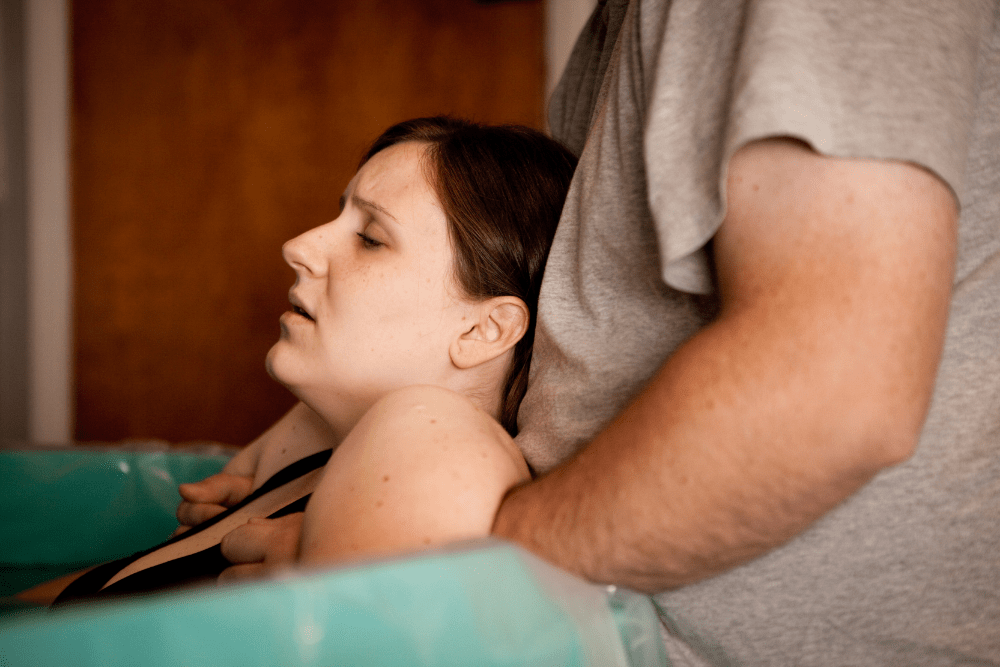Optimising Physiologic Childbirth and the Humanisation of Birth.
Birth in water is sometimes portrayed as a new-age hippy fad promoted by modern childbirth fundamentalists. This is to push the boundaries of normal birth. But, I see it as a small part of a much bigger and more sophisticated idea. Birth in water is connected to the movement to humanise birth. A movement with the potential to profoundly affect the evolution of a more conscious human culture. This will encompass supportive human relationships based on respect, compassion, care, trust and self-determination. (Beech, 1996; Bnlaskas & Cordon, 1990; Carland, 2000; Odent, 1990).
This is a powerful idea and more expansive than birth in water for its own sake. Physiologic childbirth enhances many aspects of the woman’s and newborn’s physiology: the primal adaptive system, early neural pathways and hormonal and immunologic patterns are established and influenced for life at the time of birth, in accordance with nature’s blueprint and design (Buckley, 2006; Odent, 2002). This is significant for both current and future health.
Why Water?
Modern Western culture is currently experiencing unprecedented levels of fear of vaginal childbirth. This is evidenced by the epidural epidemic prevalent amongst first-time mothers. (upward of 70% in many large public maternity hospitals in Australia, and even higher in the private sector). Additionally, according to Australian Bureau of Statistics data, the rate of Caesarean sections is now upwards of 30% in most Australian states. This surgical operation has consequent short and long-term life course morbidities for women and babies that are both physical and mental (Odent, 2004).
While pregnancy and birth are physiologic, emotional, psychological, cultural, spiritual, social and sexual experiences, predominant Western practice is to locate birth within an obstetric, specialised medical context. The privileged application of science and medicine within high-technology, centralised hospital environments (often based more on dominant ideology than sound evidence) constrains the opportunities for physiologic childbirth. This compromises the level of support, culture and services that optimise physiological childbirth, which in turn significantly influences cultural perceptions, beliefs, expectations, service choices and outcomes.
The end results are high levels of indiscriminate intervention in normal birth
It compromised rates of vaginal birth and subsequent consequences for the health of mothers, babies, families and Australian society as a whole (Donnellan-Fernandez et al., 2008). Additionally, conflict or stress between the ‘primitive brain’ and the ‘rational brain’ during labour can impede the hormones and processes that facilitate physiologic childbirth (Buckley, 2006). Water, a feminine symbol and an environmental resource, is a medium that holds the potential for effective intervention. It can help women to rediscover the instinctual embodied knowledge that optimises and supports physiologic, vaginal childbirth (Odent, 1990). The use of water enables many women to cope better with the strong sensations of childbirth.
Warm water immersion is associated with increased mobility, control, comfort, maternal satisfaction, the optimisation of instinctual behaviour and the progress of vaginal birth (Burns & Kitzinger, 2001; Balaskas & Cordon, 1990; Garland, 2000; Maude & Caplice, 2010). Importantly, it is also associated with a reduction in the use of pharmacologic pain relief and minimisation of medical interventions. This benefits mothers and babies, who are more alert, responsive and satisfied (Enkin cl al., 2000; Green, Coupland &Kitzinger, 1990). A prospective observational study undertaken in Switzerland found that babies born in the water had the lowest rate of neonatal infection. They have a higher average Apgar score at five minutes.
Women birthing in the water had the most satisfying birth experiences.
This is in addition to the lowest rate of analgesic use, lowest episiotomy rate, the lowest incidence of third- and fourth-degree tears and lowest maternal blood loss (Eberhard & Ceissbuchler, 1999). Other surveillance studies and scientific reviews have also supported the safety of birth in water for healthy pregnant women and their babies at term (Gilbert & Tookey, 1999; Nikodem, 2001). In 2010 women in Australia birthed approximately 300 000 babies. The mantra of the Maternity Coalition is Every woman, every choice. In the 21st century, it is important that midwifery knowledge and skills are able to meet the expectations of childbearing women and their families. This increasingly includes the use of water for labour and birth.
A Brief History of Water Birth
Birth in water, which has ancient origins, has attracted diverse interest over the past half century. Russian swimming instructor Igor Tcharkovsky investigated the capacities of human babies in water and the relationship between humans and dolphins, pregnant women and babies in the 1960s. Frederick Lcboyer, a French obstetrician, practised immersing newborns in warm water. This is throughout the 1960s, with the aim of casing the transition from the womb to the outside world post birth.
Michel Odent, initially a surgeon, began using a warm water pool for pain relief for labouring women at a birth centre in Pithi Viers, France throughout the 1970s and 1980s. Many women progressed to giving birth in the pool. By the 1990s thousands of women had given birth in water. The idea had spread to many Western countries as part of a movement to reclaim normal birth by using natural resources to support women’s inherent physiology (www.bellybelly.com.au/articles/birth/waterbirth-birth-in-water).
Advancing the uptake of water immersion
Many childbirth activists and educators (e.g. Janet Balaskas, Sheila Kitzingcr and Beverly Beech), supportive medicos (e.g. Yehudi Gordon and Michel Odent) and midwives (e.g. Diane Garland, Ethel Burns, Robin Maude and Shea Caplice) have sought to advance the uptake of water immersion and birth in institutionalised birth settings. By the mid-1990s the first international waterbirth conference had taken place in the United Kingdom: Water Birth Unplugged (Beech, 1996). By 2010 three quarters of UK, hospitals provided this option for birthing women. Multi-media dissemination of knowledge has been enabled by the world wide web and social networking. There is a correlation between the number of women who access information about childbirth via these sources and an increase in vaginal birth rates, suggesting that the democratisation of information may counter. I offset some of the cultural and health system influences that currently impede physiologic childbirth.
Guidelines for Labour and Birth in Water
Whilst the application of heated towels and the use of warm showers are common practices in many environments, immersion and birth in water still present a challenge and a practice prejudice for some caregivers in some settings (Wattis, 2010). There is no simple formula for the use of water during labour and birth. It is not a method that can be evaluated by double-blind studies or randomised controlled trials (although, unbelievably, some have tried – see Challenging Water Birth – How Wet Can it Get? (Kcirsc, 2005)). Attraction to water varies considerably from one individual to another and it is not a panacea for all. While it can assist some labouring women to liberate their instincts, like any intervention, it can also complicate birth if it is used unwisely (Odent, 1998).
Physical and Emotional Benefits
Warm Water Immersion:
- facilitates mobility and control; the woman herself can assume any comfortable position for birth reduces abdominal pressure
- conserves energy
- may speed up labour
- may reduce blood pressure
- promotes relaxation and relief of sensations (private, protected space, weightlessness, warmth, can enhance hormone secretion)
- reduces the need for drugs and interventions
- changes consciousness, reduces inhibition, reduces perinea trauma
- may facilitate the second stage and provide an easier birth for mother and baby
- is highly rated by women
Considerations for the Woman
As a Birthing Woman You Should:
- prepare your mind; be flexible with expectations; ensure you have a skilled attendant (midwife)
- ensure the pool or bath is comfortable: deep enough; hard or soft sides; length of time to fill
- ensure the water is clean and at a temperature of 35-38-C
- choose a suitable room with a sound floor to hold the weight of the waterfilled tub, adequate access for the birth attendant and a heat source; prepare clean towels and wraps for the baby
- eat and drink for energy: avoid dehydration – drink a minimum of 300 ml every few hours
- enter the pool in established labour / strong contractions (5 cm cervical dilation); get out if progress slows
- be prepared to deal with debris: use a sieve for clots, mucus, vomit, faeces
- adopt any position that works for you – kneeling, sitting, squatting, leaning, floating
- bring the baby to the surface when born; he or she will breathe when stimulated by air; blow on the baby’s face if they are relaxed; assess the cord for heart rate
be aware it’ is best to deliver the placenta out of water – there is a theoretical risk of water embolism - be reassured that there is no evidence of increased infection risk for mothers or babies from water; there is also no increased risk of infection for the midwife (Hepatitis A,B, C or HIV) due to virus dilution in water, although open abrasions should be covered (long latex vet gloves should be available for added protection.
Midwife Responsibilities
The Midwife Should:
- facilitate normal birth physiology for mother and baby: simple!
- maintain a private, low-stimuli environment to minimise stress hormones (noradrenaline and catecholamines) and maximise oxytocin and endorphin release
- carry out routine midwifery observations as with land, as per ACM National Midwifery Guidelines for Consultation and Referral (2008); use waterproof doppler to auscultate foetal heart rate
- remain vigilant and alert for complications as with any birth
- monitor water temperature (35-38 C) to avoid haemodynamic compromise of mother and baby; i.e. overheating, dehydration, blood pressure fluctuations and postpartum haemorrhage
- ensure adequate depth, coverage and cleanliness of water
- be discriminating about the use and timing of warm water immersion relating to progress of labour: i.e. in established labour (5 cm cervical dilation or greater) it can facilitate progress; less than 5 cm can inhibit· oxytocin and stall / prolong labour, leading to possible dehydration and exhaustion); there’s a need to assess wisely
- maintain the woman’s hydration: water intake; cool cloth for face; spray mist bottle
- perform vaginal examinations (if necessary) in the water or ask the woman herself
- encourage the woman to follow her body’s natural urges to push / breathe her baby out; hands-off birth is fine as water supports crowning and perineum, although many women instinctively support their own perineum
Midwife must:
- bring the baby to the surface within the first few moments of birth to initiate respiration in air and await cessation of cord pulsation; water babies are often very relaxed and appear asleep when brought to the surface; the mother can be encouraged to blow on the baby’s face and provide tactile stimulation if required; have resuscitation equipment prepared and ready as for standard midwifery practice
- keep the mother and baby warm; ensure accurate estimation of blood loss (often there is none apparent) – note the colour of water: ‘Rose is OK; Claret is NOT’ (although assessing the status and condition of the woman’s response is the best guide); some institutions such as Women’s & Children’s Hospital in Adelaide have developed visual charts to guide estimation of blood loss
- Observe closely for signs of placental separation (i.e. lengthening cord; gush of blood; contracted fundus) find exit the pool for warm wraps and birth of placenta
- third stage management: there is a theoretical risk of water embolism in water, although the placenta is sometimes birthed quickly prior to the woman exiting the bath
- initiate early breastfeeding and routine care and post-birth
- observations, including support of the family be aware of Occupation Health & Safety Considerations: consider back care when attending a woman in a pool; minimise infection risk for self and other users of the facility by ensuring appropriate care and cleansing of equipment (Maude & Caplice, 2010)
Originally Published in Midwifery Matters: Donnellan-Fernandez, R. (2011). Birthing in water: supporting women with midwifery knowledge and skill. Birth Matters, 15(3), 20-21.
Page revised on 20th December 2021

 Wish List
Wish List

Recent Comments